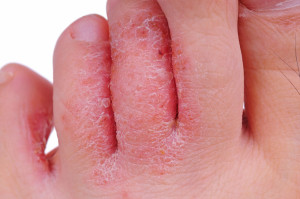Introduction
Athlete’s foot and toe fungus infection has the medical name “tinea pedis”. Usually the fungus Trichophyton mentagrophytes causes this.
It leads to a breakdown of the skin usually between the 3rd and 4th toes or the 4th and 5th toes.
Without treatment it will spread to the sole of the foot and often to the other foot. The skin is macerated and the borders are scaling. There are blisters that break open later.The skin get super-infections with bacteria and can also infect the lymphatic vessels causing lymphangitis and lymphadenitis. The physician makes the diagnosis clinically most of the time and also treats it accordingly.
However, in cases where the physician is unsure of the diagnosis the option is to do a swab for bacterial or fungal culture. If there is still a doubt about the diagnosis the physician does a biopsy for histology to rule out other conditions.
Treatment
Milder cases of athlete’s foot will respond to topical treatment with antifungal solution or cream such as ciclopirox (brand name: Loprox cream or lotion). Sometimes the infection has been there for some time and the physician notices that nails have fungal infections as well. In this case a course of oral antifungal medication such as itraconazole (brand name: Sporanox) 200 mg once daily for 1 month helps. Alternatively, terbinafine (brand name: Lamisil) 250 mg once per day for 2 to 4 weeks is another option. The physician will monitor liver and kidney toxicity.
References
1.The Merck Manual, 7th edition, by M. H. Beers et al., Whitehouse Station, N.J., 1999. Chapter 265.
2.James Chin et al., Editors: Control of Communicable Diseases Manual, 17th edition, 2000, American Public Health Association
3.The Merck Manual, 7th edition, by M. H. Beers et al., Whitehouse Station, N.J., 1999. Chapter 112.
4. The Merck Manual, 7th edition, by M. H. Beers et al., Whitehouse Station, N.J., 1999. Chapter 115.
5. The Merck Manual, 7th edition, by M. H. Beers et al., Whitehouse Station, N.J., 1999. Chapter 113.







